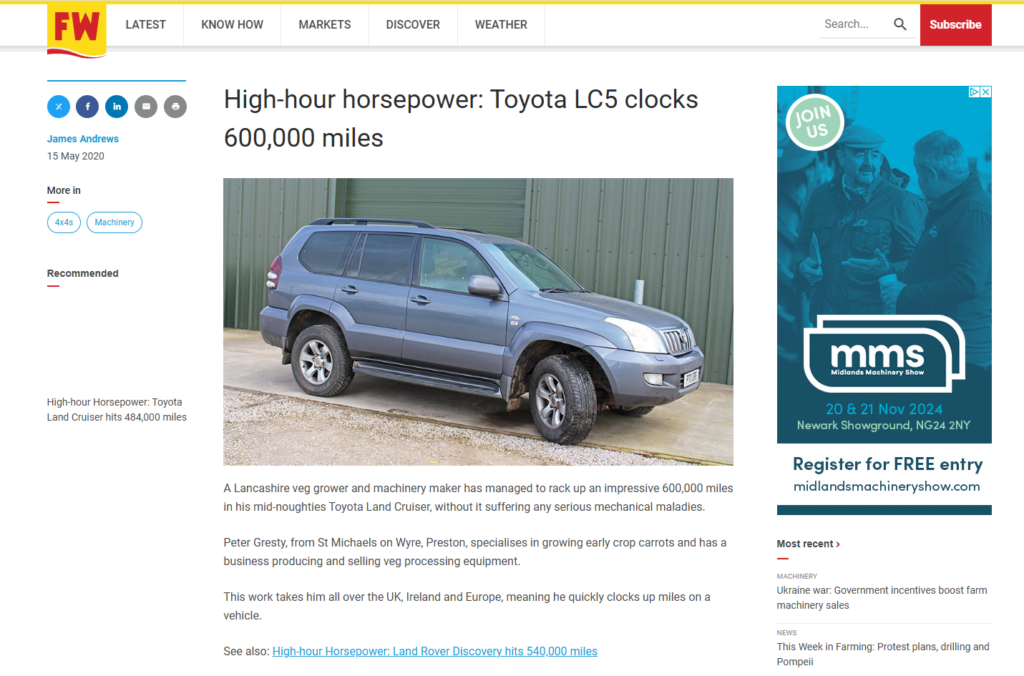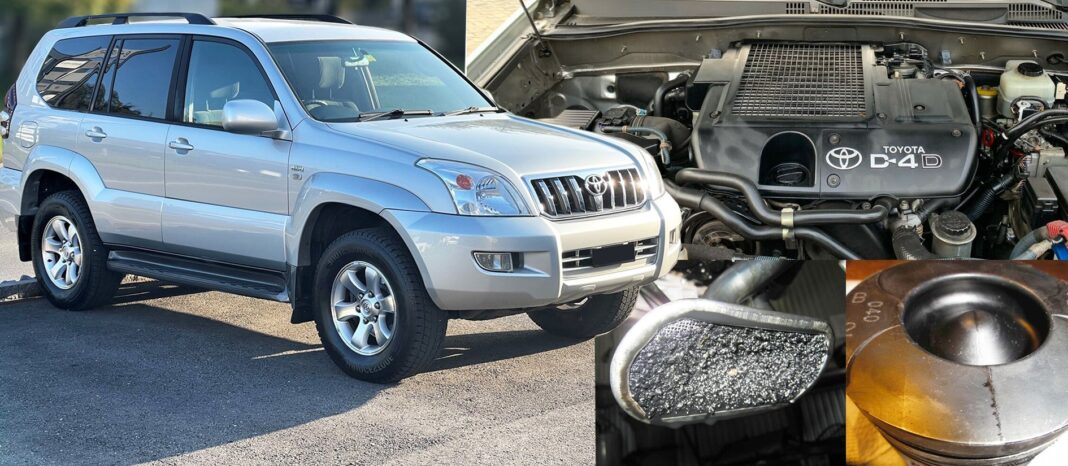This is gonna be a longer and somewhat thorough article, so brace yourself !
First of all, let’s briefly check out two high-mileage examples, which might help paint a clearer picture of these cars before we get to the more serious stuff.
an example with 595 000 mi / 957 000 km

HERE is an article about a 2004 Land Cruiser Prado with the 161 hp 3.0 D4D diesel engine with almost 600 000 mi. The car has a 5 speed automatic gearbox and the optional air suspension on the rear axle.
If you can’t open the article here are the things which were replaced on this car:
- injectors after 60 000 mi
- rear suspension air struts
- air suspension air compressor
- alternator (a few times)
- the multimedia system broke but was repaired
- regular maintenance items (batteries, brakes, wheel bearings)
- currently the AC is not working
service is carried out every 10 000 mi – oil change + filters, and the timing belt is replaced every 60 000 mi
the car has original engine and gearbox
an example with 484 000 mi / 779 000 km

HERE is an article about a 2008 Land Cruiser Prado with the 170 hp 3.0 D4D diesel engine with almost 484 000 mi. The car has a 6 speed manual gearbox and a standard coilover suspension.
If you can’t open the article here are the things which were replaced on this car:
- injectors under warranty
- drivers airbag squib (the component that sets the airbag off)
- windscreen wiper linkage
- starter motor
- alternator
- brake calipers
- regular maintenance items (battery, brakes, wheel bearings)
service is carried out every 10 000 mi – oil change + filters, and the timing belt is replaced every 60 000 mi + gearbox and differential fluids are replaced every 95 000 mi + the owner never lets it idle for long periods when warm
the car has original engine and gearbox, clutch and turbo
As you can see, the 3rd generation Toyota Land Cruiser Prado—also known as the Land Cruiser 120—is capable of reaching very high mileage with minimal issues. There’s no doubt about that. If you need a comfortable, well-built off-road car but don’t want the legendary, larger Land Cruiser, this is an excellent choice. And based on those two examples, it has bulletproof reliability!
But is it really that straightforward? Well, not really. While it’s true that the petrol engines in these cars are great and reliable (but very thirsty), the diesel engines can have a couple of issues which can destroy them. So let’s check them out more closely!
Believe it or not, this Toyota was available with 3 types of 3.0l 4 cylinder diesel engines:
5L-E
The 5L-E is very simple and very reliable. But it doesn’t have a turbocharger so it has that much power as a retired snail smoking weeeeed, and it’s so rare, that even I’m not sure if it was really available in these cars (it was, they say). So let’s just move onto the other slightly more popular engine – the 1KZ-TE.
1KZ-TE
This 1KZ is not that powerful either, but it’s generally speaking reliable without unexpected issues. However if you manage to overheat it – then you will end up with a cracked cylinder head, so make sure that the cooling system of the engine is working properly:
- check for coolant leaks
- check the viscous fan clutch which can fail (video about fan hub issues)
- check the radiator if it’s not clogged
- don’t tow very heavy stuff and don’t push the car very hard in hot weather
(cracked cylinder head symptoms: coolant loss without visible leak, oil in the coolant, bubbles in the coolant overflow tank, overheating, white gunk under the oil cap, steam from the exhaust)
Also if you change the oil in this engine every 8 000 km / 5 000 mi then you will maximize the lifetime of the mechanical components a.k.a. the engine is gonna live forever with this oil change interval (until you overheat it).
Also, before buying it’s good to rev the engine and check for smoke from the exhaust (also during acceleration). This is usually the sign of worn injectors which are not gonna last forever. After 300 000 km it’s actually good to replace them even preventively to keep the good efficiency and performance of the engine.
If this engine is in good condition then you should not see smoke from the exhaust at acceleration-when the engine is warmed up to operating temp
1KD-FTV
This is the newer, most known and most common engine which can have various power outputs: 120 KW, 122 KW, 127 KW.
It has an iron cylinder block, an aluminum cylinder head, 1 electronically controlled turbocharger, common rail injection and a timing belt. All of this sounds ok. And actually, I can’t say that this engine would be bad, since all the main mechanical components can withstand more than 500 000 km without much wear. Well, except maybe the pistons? Yes, those pistons… Once upon a time in the year 2006 Toyota slightly upgraded these engines to comply with the EURO 4 emission standards, and they also got new pistons! But let’s not overtake the things, because there are also the injectors!
on the next page: 1KD-FTV ENGINE ISSUES















Any chance of adding a link to the Toyota Service Bulletin about the different injectors and pistons ? It is very hard to read from the YouTube video. I have a 2006 type 1 Fortuner with 1Kd ( bought new in Thailand but brought to Australia in 2011. I believe originally was Euro2 so hopefully no piston issues. I DO tow a 1800 kg caravan in Oz….Now has 190 k km so I guess time for injector change.
I uploaded the bulletin under the article
Hi, Thanks for the advice.
Presently I have an issue with my 2013 Prado. This morning it lost power. Oil & water & temperature was fine. It looks like my No. 2 cylinder stopped working. Power is down to 15-20%
Unfortunately, timing is poor. I’m towing a small caravan from one side of Australia to the other. I’m stuck at an isolated fuel stop. The nearest town behind me is 470km and the nearest town in front of me is about 750km. I can drive at maybe 60kph and right now I have a little bit of internet. I wonder how much damage I will cause by trying to drive on 3 cylinders.
Hi
I would not recommend you to drive the car any further mainly if you don’t know the exact cause of the issue, because there is a high chance that you are gonna end up stranded with a seized and ruined engine-mainly if you plan driving that long distance.
For example, if you have a cracked piston(-with a crack on the side of the piston) and you are gonna drive the car, then because of the heat and the crack the piston expands more than it should and it can get seized a lot which is gonna damage not only the engine block but also the crank.
Also if you have a leaking injector, then that is also gonna cause a cracked piston-if its not cracked already + the excess fuel will get into the oil – and too much fuel in oil will cause a seized and ruined engine.
The only time I would maybe drive the car would be if the injector is stuck in closed position and the piston would be fine with no crack-or if the crack/hole in it would be small and not on the side. But the problem is that you can’t check this properly without looking into the cylinder, and even in that case I would not drive the car more than 100 km.
Also, if currently your issue is just a small crack in the piston or just a faulty injector then the repair is not gonna be very expensive if the other components are fine, however with driving the car you can cause bigger engine damage which is not gonna be that cheap to repair.
did they fix this with the Euro5 3.0 Diesel? 2014/ 2015? not the 2.8 model.
not completely since these engines still don’t have the newest pistons fitted and there are rare cases of piston crack even in these versions, but there is a much much smaller chance of this issue than on the older engines
the latest updated piston version for these engines was introduced in 2017 – this version should be the most durable